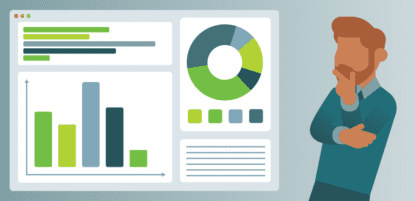Today MineralTree published its 7th annual State of AP Report, distilling hundreds of survey responses from finance professionals into a detailed report that shares key findings and AP trends for 2022 and beyond.
Over the last 7 years, MineralTree has tracked countless trends across the AP landscape, following the evolution of B2B payments, back office digitization, and business priorities for finance. We’re especially thrilled to roll out our 2022 edition with an exciting new addendum. This year’s report takes our AP research one step further by including data from our first-ever vendor survey, providing a unique perspective into the minds of strategic suppliers, their payment priorities and pain points.
With over 900 responses from AP teams and nearly 200 responses from suppliers, our 2022 State of AP report is chock-full of valuable data points. Today’s blog serves as a sneak peak by sharing five of the most crucial AP stats to know this year.
But the insights don’t stop there. Make sure to focus on the greater business trends these numbers highlight: growing vendor relationships, ePayment adoption, and AP automation to combat continued hiring challenges and supply chain disruptions. Download this year’s State of AP report to get a closer look into how these trends are affecting today’s world of AP.

5 AP Stats to Know for 2022
1. Vendor relationships grew more important over the last year for 70.8% of firms.
This is likely due to supply chain disruptions over the last two years, which have made it increasingly difficult for businesses to source necessary goods for their organizations. As organizations scramble to find reliable suppliers amidst these unpredictable supply chains, their perspective on vendor relationships have shifted. As a result, firms now increasingly prioritize their vendors.
2. 54.3% of organizations anticipate challenges or delays in hiring quality AP staff.
“The great reshuffle” has left most organizations struggling to fill open roles and retain their current roster of employees – this is especially true for roles in the back office like AP.
More than half of firms this year anticipated challenges or delays in hiring quality AP staff. On one hand, this spells out larger efficiency issues for understaffed teams that are still expected to meet regular output goals. However, this situation also prompts firms to seek out alternative solutions like AP automation in order to bridge looming efficiency gaps.
3. 68.6% of firms work hybrid or remote today.
The face of AP work is changing. Accounts Payable has traditionally been a back-office team that must go into the office in order to complete their duties. That is, until COVID-19 turned AP on its head.
Before the pandemic, 84.7% of AP teams worked completely in the office. Today, that number has dwindled to just 31.4% (down even from last year’s 38.1% of AP staff working in the office). The early stages of the pandemic forced many AP teams to abandon their traditional models in favor of systems like AP automation that enabled remote and hybrid work models. It’s likely that hiring challenges continue to drive the popularity of hybrid and remote AP teams, as more firms realize that offering hybrid or remote roles can attract more applicants for unfilled positions.
4. 82.2% of suppliers want to receive more electronic payments from their buyers.
One of the largest trends from this year’s survey revolves around the rise of ePayments. Buyers and suppliers alike report wanting to increase their use of digital payments, resulting in a decline of check usage. With vendor relationships more important than ever, it’s likely that many firms are shifting their payment mix over to digital payments in an effort to appease their strategic suppliers, while also racking up benefits like virtual card rebates and increased security protection.
Although ePayments are gaining popularity, there seems to be an interesting blame game of sorts emerging between vendors and their buyers. Download our 2022 State of AP to get the full story, along with even more stats around ePayments’ growing influence and general payment mix trends.
5. Only 16.2% of organizations have fully automated their AP workflow.
Despite the fact that many teams have started to automate parts of, or their entire end-to-end AP workflow, only a small fraction of teams have completed their AP digital transformation. This gap demonstrates the ample benefits that remain to be realized in the AP automation space.
Looking for more information? Get a detailed view into the modern AP business landscape by downloading the complete 2022 State of AP report. It includes even more AP stats, along with expert insights on how these data points manifest across the back office.



